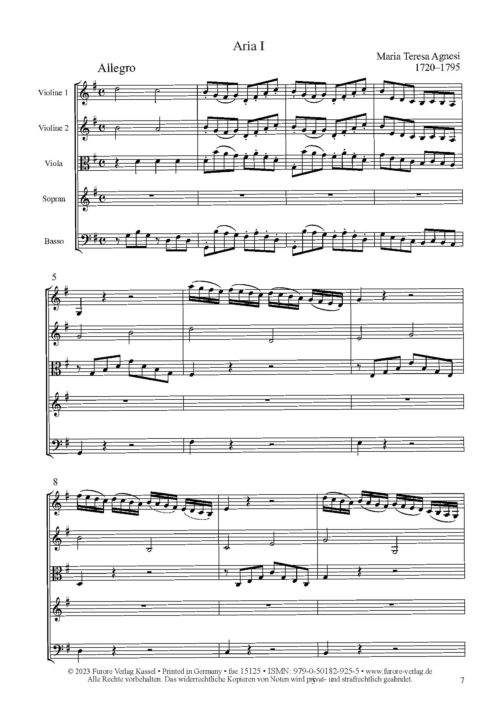Maria Teresa Gaetana Agnesi, whose elder sister Maria Gaetana was a famous scientist and philanthropist, was born in Milan on 17 October 1720 as the third child of textile trader Pietro Agnesi Mariani and Anna Fortunata Brivio. “In view of the renown that she acquired in her early years for her performances at academic evenings organised by her father in their own home, it can safely be assumed that she had received music tuition from a very young age. […] Crown Prince Friedrich Christian of Saxony and Markgraf Carl of Wolfenbüttel, were also guests at the Agnesi residence.
The connection to Dresden was to be intensified during the 1750s: Maria Teresa sent a collection of arias to Electress Maria Antonia Walpurgis, herself an active composer and performer.”1
The three arias published here are taken from that collection. “It is documented that even Empress Maria Theresia of Austria herself had Maria Teresa Agnesi’s arias performed.”2 “The 12 arias prove her ability to mirror the emotions of a dramatic situation through harmony, vocal setting and instrumentation.”3
The year 1752 marked a watershed in her life: her father (who had become feudal lord of Montevecchia in 1740) died suddenly and, only three months later, Maria Teresa married Pietro Antonio Pinottini (Milan 1723–1792), something her father had previously denied her.
From this point on, she devoted herself almost entirely to music. Alongside concertos, sonatas, fantasies and chamber arias, she composed several operas, writing some of the libretti herself. In 1753, Maria Teresa received official recognition with the judgement of Giammaria Mazzuchelli: “MariaTeresa si distingue in modo particolare nella cognizione della musica, nella quale è la meraviglia de’ più rinomati Professori di tal arte ch’ella non abbia pari in Europa, ma compone essa con tale idea, gusto, intelligenza, ed espressione di parole, con tale novità di stile, e con tali motivi, per parlare co’ nomi dell’Arte, da sorprenderne chicchessia”.4 In his 1868 novel “Cento anni”, Giuseppe Rovani describes her as “la sola compositrice di musica drammatica ricca di fantasia e di dottrina, che vanti ancora la storia dell‘ arte”.5
When Leopold Mozart travelled to Italy in 1770 in order to introduce his son, Maria Teresa met the 14-year-old Wolfgang Amadeus on 7 February of that year at a concert organised in his honour. There followed a challenging time for Maria Teresa with financial difficulties, and she had to ask one of her sisters for help. She died on 19 January 1795, two years after the death of her husband.


